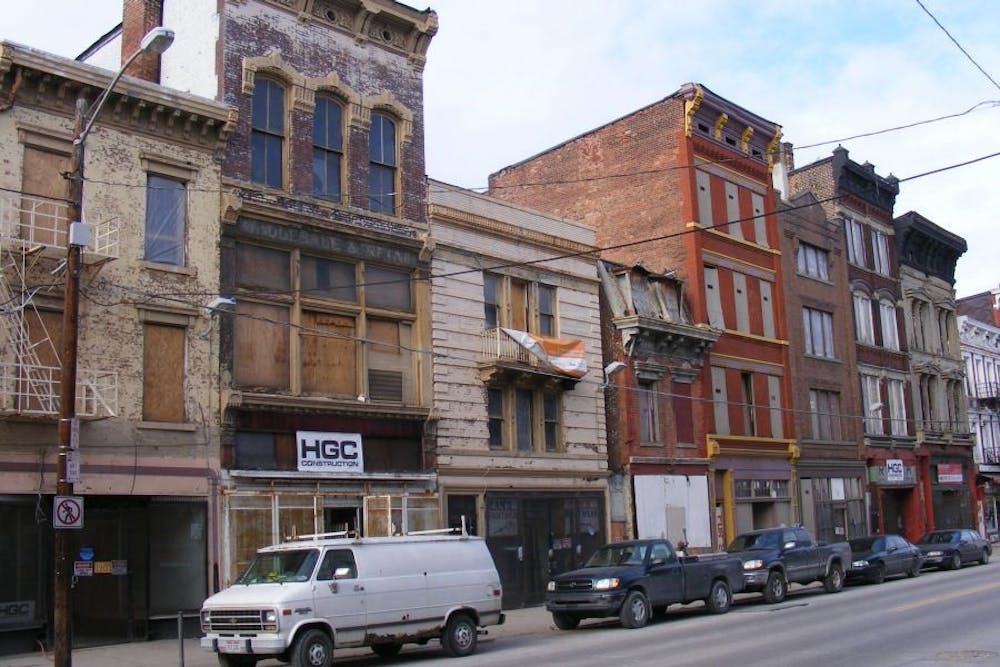Part 3 in a series: the refugees of "urban renewal"
By Tess Sohngen, Over-the-Rhine Correspondent
"Urban renewal" has become synonymous with "Negro removal" for many residents in Over-the-Rhine who have witnessed the neighborhood's dramatic changes over the past fifteen years. But "urban renewal" and "Negro removal" are not new concepts to Cincinnati.
Before Over-the-Rhine, Cincinnati's West End received the most criticism for its crime, crowded housing and overwhelming poverty. The U.S. Census reported 45,358 people in the West End in 1950. But the community was bulldozed - quite literally - in the late 1950s for the construction of I-75, demolishing many homes in what social worker Dr. Alice Skirtz, author of Econocide: Elimination of the Urban Poor, called a "massive slum clearance and urban renewal effort."
By 1990, the population of the West End dropped to 11,439.
Some of the families displaced by the construction of I-75 moved to the only other neighborhood in Cincinnati that provided units of affordable housing: Over-the-Rhine. From then until the early 2000s, Over-the-Rhine became the heart of affordable housing and city-funded housing units. It also inherited the label as the poorest, most crime-riddled area of Cincinnati.
The city spent an estimated $100 million toward low-income rental units from 1970 to 1990, a figure estimated by Housing Opportunities Made Equal (HOME) in their report Over-the-Rhine: a Permanent Ghetto?
This report - unsourced and absent of economic and social implications - claims "anecdotal evidence tends to support the common belief that poverty has increased in Over-the-Rhine during the past two decades as has the incidence of crime and many other social problems associated with concentrations of the poor and the desperate."
The city used this report -- among other analyses and pressure from councilmembers and businesses -- and the riots following the shooting of Timothy Thomas by police patrolman Stephen Roach to ignite the "urban renewal" in Over-the-Rhine.
In 2001, then city council member John Cranley introduced an Impaction Ordinance that "forbid the City of Cincinnati from spending, approving or in any way condoning more subsidized low-income development in those areas deemed impacted, except for projects needing rehabilitation that currently contain subsidized low-income housing..."
Many activists and nonprofit housing groups in the community opposed the ordinance. As a rebuttle to the ordince and the HOME report, activists and university professors Tom Dutton from Miami Unversity and Jonathan Diskin from ... wrote A Rush to Judgement, in which they stated:
"To pull the plug on new nancing for non-profit housing development in Cincinnati's poorest neighborhoods would effectively destroy the community based institutions that have been laboring for years, at extremely low levels of compensation, to meet the needs of Cincinnati's poorest citizens. Further, community based, non-pro t ownership is the only guarantee against the possible waves of gentrification and abandonment to ensure that economic mix has any purchase."
Enjoy what you're reading?
Signup for our newsletter
City Council voted to adopt Cranley's motion later than year.
Shortly after, the city's Planning Department completed the Over-the-Rhine Comprehensive Plan in 2002 that focused on "mixed-income" housing. One major goal of the Plan was "Encourage and welcome new investment at all income levels of the housing market and ensure the long-term sustainability of enough affordable housing to house current residents". One year later, the city eliminated the Planning Commission, leaving the responsibility for fulfilling the mixed-income housing goals for Over-the-Rhine in the hands of 3CDC and other developers.
While 3CDC and others successfully brought higher-income individuals and families into the community and made strides toward creating a mixed-income neighborhood, affordable housing took a major hit. The number of units of affordable housing - units in which people pay 30 percent or less of their income toward rent - fell from 3,325 in 2002 to 869 in 2015, according to Mary Burk Rivers, Executive Director of Over-the-Rhine Community Housing. Whereas the Plan's goal listed maintaining affordable housing for current residents, the execution of the Plan has resulted in ornate, market-rate condos scattered through a grid of vacant, boarded-up buildings once called home.
Over-the-Rhine's population continued to decline even after the exodus from the West End, a descend that begin in 1950s when 63 percent of the white population moved out of the neighborhood, according to the Cincinnati Planning Department's Historic Conservation Board. The decline has continued still. The overall population dropped from 7,638 in 2000 to 5,610 in 2014, according to the 2015 Housing Inventory, compiled by the Community Building Institute at Xavier University. Since 1950, Over-the-Rhine has yet to experience a decade of increased population or housing units.
For the residents by Findlay Market where the wave of "urban renewal" has already broken ground, the history of decline is an old song still sung through the streets of their community. This autumn, they could add eight more tallies to the number of lost units of affordable housing.




